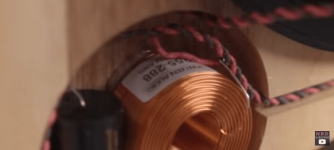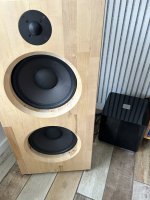I have only finished one loudspeaker for measuring and testing in a test board and for a loudspeaker it is amazing that it plays so low, so you don't need a sub at all.
Yes, I dont like DSP crossover. I'll wait until I'm done with the second one and then after another measurement I'll report here what it turned out to be but I can already say that they sound very good and have a very clean basswow!!! congratulations!! The measurements look amazing! Did you design the passive crossover?
Congratulations to make it work !Caladan measurement cross. ca 1kHz
Phase tracking doesn't seem so good. Perhaps a four order crossover on the tweeter ?
I experimented this kind of design but I never make it sound good to my ears. You should make a CSD to see the storage energy. I remember between 500 - 1kHz you have dipole dips and stored anergy.
This project looks like John Bush Manzanita at its early stage, but John's design has less technicals challenges.
Congratulations again and wait to see the work in progress !
This is based on original crossover point at 1 Khz which does not mean that you can not separate higher I have also tested it with 1250 Hz but it is too mid-heavy for me and therefore a low crossover point frequency was also chosen in the original so that it does not sound tiring even during longer horsessions.
"four order crossover on the tweeter ?" to separate it that low is technically not possible with 4th order without shifting the separation at 2-3 kHz. In this project, the role was given to the tweeter, which a midrange driver could normally do well. I will be able to tell you later how it will sound in the end.Congratulations to make it work !
Phase tracking doesn't seem so good. Perhaps a four order crossover on the tweeter ?
I experimented this kind of design but I never make it sound good to my ears. You should make a CSD to see the storage energy. I remember between 500 - 1kHz you have dipole dips and stored anergy.
This project looks like John Bush Manzanita at its early stage, but John's design has less technicals challenges.
Four order is to add time delay on the tweeter. Not really to add more slope. To make a long story short, it improves a lot of things but exhibits some others technicals issues. It is a difficult work to find the best compromise. This is why some people used DSP, faster to to tune...
I used this technique with a mini Manzanita in 2009 but the host pictures have been lost. See if I can find the original images ( Post mini Mazanita )
Again good job !
I used this technique with a mini Manzanita in 2009 but the host pictures have been lost. See if I can find the original images ( Post mini Mazanita )
Again good job !
Yes, it is very important to time (delay) the tweeter precisely for this reason the panel is tilted backwards to balance the acoustic centreFour order is to add time delay on the tweeter. Not really to add more slope. To make a long story short, it improves a lot of things but exhibits some others technicals issues. It is a difficult work to find the best compromise. This is why some people used DSP, faster to to tune...
I used this technique with a mini Manzanita in 2009 but the host pictures have been lost. See if I can find the original images ( Post mini Mazanita )
Again good job !
Thank you very much for your suggestions I will test with 4th order to see how it sounds.
A little history of how kor952 and I came at the values of the filter. After watching various videos and photos, we saw Jantzen audio *55-288 on the coil of the woofer. If you search for that in Google you will come across the Jantzen audio 255-288 and that is a 7mH coil. In the photos you can clearly see that Jantzen audio 20uF capacitors are used for the tweeter and woofers. With an extra capacitor and resistor in the tweeter network. After building it, my expectations were quite high after seeing Ron from New Record Day. But it was very disappointing. So I am very curious to see what values babus comes up with.
I am not understanding how the woofers can be 7mh for the 4 ohm load...isn't that like 90hz low pass?
If it were .7mh and 20uf, then that would be 1k first order for an 8 ohm tweeter and two 8 ohm woofers in parallel (4ohm)....sorry if this was mentioned earlier....to lazy to re-read entire thread...
Attached is my Emerald Physics CS2 clones (parallel Eminence 15A with Heil AMT tweeter) driven by two Hypex UCD400HG Hxr stereo amps with Marchand XM44 active crossovers at 1k 48db/Octave LR slope, and REW EQ'ed source.
Sounds great! But I think a Passive XO is quite fine (me thinks) on these types- high efficiency Open Baffle ..... I have been playing with First Order Parallel and Serial XO (.7mh / 20uf) and still need to do some critical listening with them to finalize an opinion.
But isn't Active Bi-amping really only beneficial when tweeters, mids, and woofers are low efficiency and all fighting for the limited power from an amp (think Magnepans, or Martin Logan Hybrid ESLs - where both ESL mid/tweeter & conventional sealed woofer are both low efficiency, needing all the power you can throw at it)?
In my (our) case, since the tweeter is more efficient than that paralleled woofers (after EQ), its not being "starved" of power.
I expect the Series or Parallel first order should win out over active Bi-amping, and simplify my entire system.
If it were .7mh and 20uf, then that would be 1k first order for an 8 ohm tweeter and two 8 ohm woofers in parallel (4ohm)....sorry if this was mentioned earlier....to lazy to re-read entire thread...
Attached is my Emerald Physics CS2 clones (parallel Eminence 15A with Heil AMT tweeter) driven by two Hypex UCD400HG Hxr stereo amps with Marchand XM44 active crossovers at 1k 48db/Octave LR slope, and REW EQ'ed source.
Sounds great! But I think a Passive XO is quite fine (me thinks) on these types- high efficiency Open Baffle ..... I have been playing with First Order Parallel and Serial XO (.7mh / 20uf) and still need to do some critical listening with them to finalize an opinion.
But isn't Active Bi-amping really only beneficial when tweeters, mids, and woofers are low efficiency and all fighting for the limited power from an amp (think Magnepans, or Martin Logan Hybrid ESLs - where both ESL mid/tweeter & conventional sealed woofer are both low efficiency, needing all the power you can throw at it)?
In my (our) case, since the tweeter is more efficient than that paralleled woofers (after EQ), its not being "starved" of power.
I expect the Series or Parallel first order should win out over active Bi-amping, and simplify my entire system.
Attachments
Last edited:
Maybe he did it to throw off reverse engineering attempts??
I think you will have a rather large "hole" from 100 to 1000hz if 7mh used....
Unless there is a .7mh in parallel with that 7mh (gives .64mh).
If really only a 7mh in series to woofer, clip a .7mh across it and listen
I think you will have a rather large "hole" from 100 to 1000hz if 7mh used....
Unless there is a .7mh in parallel with that 7mh (gives .64mh).
If really only a 7mh in series to woofer, clip a .7mh across it and listen
Last edited:
I have to share your findings. I was also disappointed at the sound of my Caladan clones and Ron is a paid reviewer like most of them. Lesson learned.A little history of how kor952 and I came at the values of the filter. After watching various videos and photos, we saw Jantzen audio *55-288 on the coil of the woofer. If you search for that in Google you will come across the Jantzen audio 255-288 and that is a 7mH coil. In the photos you can clearly see that Jantzen audio 20uF capacitors are used for the tweeter and woofers. With an extra capacitor and resistor in the tweeter network. After building it, my expectations were quite high after seeing Ron from New Record Day. But it was very disappointing. So I am very curious to see what values babus comes up with.
Attachments
Caladan measurement cross. ca 1kHz
Measurements are practically meaningless when viewed with this coarse of a y-scale.
I kinda agree - look at response at 1/6 smoothing...or lessMeasurements are practically meaningless when viewed with this coarse of a y-scale.
Is there someone here with som woodworking skills that could shed some light on how to chamfer the edges on the bass driver openings the best way? You'll get a gold star if it doesn't involve the biggest router bit in Europe! Also, I would love to keep my fingers attached to my hands. 😉
What kind of angle are we talking? 30, 40 degrees?
What kind of angle are we talking? 30, 40 degrees?
- Home
- Loudspeakers
- Multi-Way
- Caladan by Clayton Shaw DIY
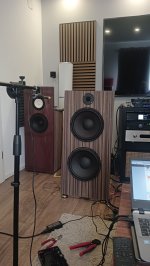
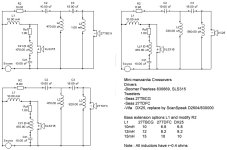
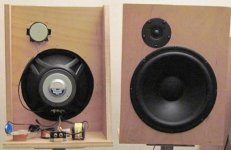
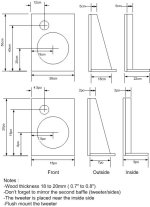
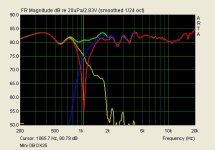
![PXL_20240717_170059434[1].jpg](/community/data/attachments/1242/1242669-1b7594a789fcc4c38718a107da55c86a.jpg?hash=G3WUp4n8xM)
